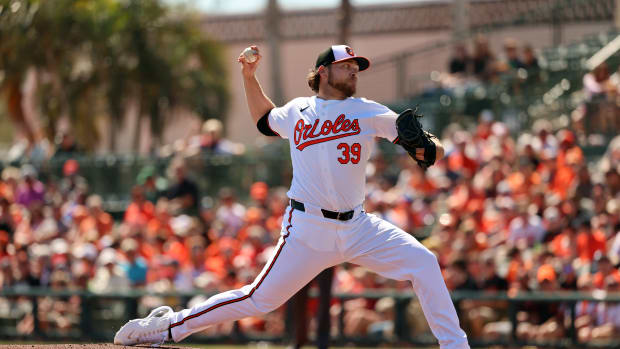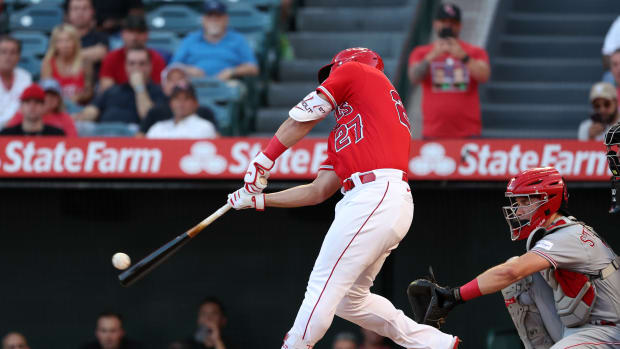
Winners and losers from surprising first day of MLB draft
The surprises began with the very first pick of the 2012 MLB draft -- when the Astros selected Puerto Rican shortstop Carlos Correa instead of the widely expected choice, Stanford righthanded pitcher Mark Appel -- and didn't stop there. Here's a quick look at the winners and losers from the first round and the compensation round.
The Astros made a daring, courageous pick by choosing Correa. Instead of taking a safe, close to the majors college righty in Appel, Houston selected a player who may take some time to reach Minute Maid Park but promises to become a franchise cornerstone player.
Any starting pitcher can only help a club every five days; a middle of the field, middle of the order player can help every day for five, 10 or even 15 years. Derek Jeter, whom Houston could have selected the last time it had the No. 1 overall pick, back in 1992, is one famous example. Correa does everything well. His speed is above average, he has a terrific arm, is an exceptional defender and projects to hit for power and average. He's the only prep player I've ever seen who, using a wood bat, hit a line drive home run directly down the line to his opposite field. Not even Bryce Harper.
2. Toronto Blue Jays
The Blue Jays have a unique scouting system. While other organizations divide territories into large geographic regions. Toronto divides territories into small, bite-sized chunks in high-talent regions like Texas, Florida and California and use unpaid volunteers to chart pitching for top pitching prospects. Such an approach looks to have paid off this year, as the Blue Jays enjoyed a phenomenal draft. They snagged terrific pitching in Marcus Stroman (No. 22), Matt Smoral (No. 50) and Tyler Gonzales (No. 60, the last pick of Day 1), plus they added high school hitters with tremendous potential in D.J. Davis and Mitch Nay.
3. Los Angeles Dodgers
The Dodgers have needed a standout third baseman since Adrian Beltre left for Seattle after the 2004 season. To remedy that, the Dodgers picked up Corey Seager, a prep standout from North Carolina who not only boasts a big league sibling (the Mariners' Kyle) but whose arm, glove and bat have All-Star written all over them.
4. Oakland Athletics
Quietly, the A's have let the "Moneyball" era pass and are intelligently adapting to new realities. The team that made eschewing high school players in favor of college picks famous selected three high schoolers -- Addison Russell (pick No. 11), Daniel Robertson (No. 34) and Matt Olson (No. 47) -- to potentially form the core of their future infield. Russell and Robertson are left side of the infield youngsters with impressive defensive skills and power potential while Olson reminds some of the Braves' gifted first baseman, Freddie Freeman.
5. Minnesota Twins
After winning their sixth AL Central title in nine years in 2010, the last-place Twins must be dizzy having fallen so far so quickly. With his stunning five-tool talent, Georgia high schooler Byron Buxton (No. 2) will help Minnesota recover. Orlando Berrios (No. 32), a righty from Puerto Rico, and Georgia Tech's Luke Bard will shore up a thin pitching system. Berrios has a loose, easy arm with a nice fastball and a chance for fine secondary pitches. Bard has big league bloodlines -- his brother Daniel pitches for the Red Sox -- with solid but unspectacular stuff but clean mechanics. The Twins usually go for pitchers who, while not big and projectable or possessing mid-90s fastballs do have command, high pitching IQs and the ability to gobble up innings.
1. New York Mets
Gavin Cecchini, a high school shortstop from Louisiana, is not a bad pick per se. He's a good fielder with great instincts. However, considering who was still on the board when New York picked him at No. 12, the choice of such a far-from-developed hitter is baffling. Offensively-gifted outfielders Courtney Hawkins (No. 13 to the White Sox), Tyler Naquin (No. 15 to the Indians) and D.J. Davis (No. 17 to the Blue Jays) were available, as was the aforementioned Seager were available, making the Mets' decision a head scratcher.
2. St. Louis Cardinals
Michael Wacha, the Texas A&M righty taken at No. 19, was a wonderful selection. James Ramsey at No. 23 was a shocker. No doubt Ramsey, an outfielder from Florida State, has strong "makeup" and some hitting ability but he is glaringly short on tools like running, throwing and fielding well. This pick appears to be a straight sabermetric choice, as Ramsey has a .520 on-base percentage a .683 slugging percentage and 13 home runs.
Ramsey clearly has power but he does not possess a true pro body or athleticism. As a college senior, the Cardinals may be able to get him to sign below slot to apply the leftover money to others they drafted. Compare that to Naquin, who is tall, projectable, athletic and has a sensational arm, some speed and a quick bat.
3. Washington Nationals
The Nationals are taking a colossal gamble with Lucas Giolito. In addition to injury concerns -- he missed his senior season of high school at Harvard-Westlake in Studio City, Calif., with a sprained ulnar collateral ligament in his pitching elbow, the flame throwing righty is thought to be exceptionally difficult to sign. Washington obviously feels the gamble is worth the risk, because a healthy Giolito would be this draft's top arm. He's 6-foot-6, throws in the upper 90s and is more advanced than Stephen Strasburg, the No. 1 pick by Washington out of college three years ago, was at the same age.
The Red Sox went for college players with their first round selections, taking Arizona State shortstop Deven Marrero at No. 24 and Florida pitcher Brian Johnson at No. 31. There's nothing wrong with that, but those two are not exactly scintillating. Marrero, for instance, is an advanced defensive shortstop with decent speed, but serious doubts persist regarding his bat. Johnson, meanwhile, profiles as a back-of-the-rotation starter.
5. San Francisco Giants
The Giants are an exemplary organization, traditionally doing an admirable job of drafting and developing players. They habitually draft mature college pitchers with their first round picks. However, considering how starved the Giants are for both offense and power, this may have been the year to vary the blueprint. Instead, they selected Mississippi State righty Chris Stratton at No. 20 while big bats like Clemson's Richie Shaffer (No. 25 to the Rays) and Stanford's Stephen Piscotty (No. 36 to the Cardinals) could still be had.



































